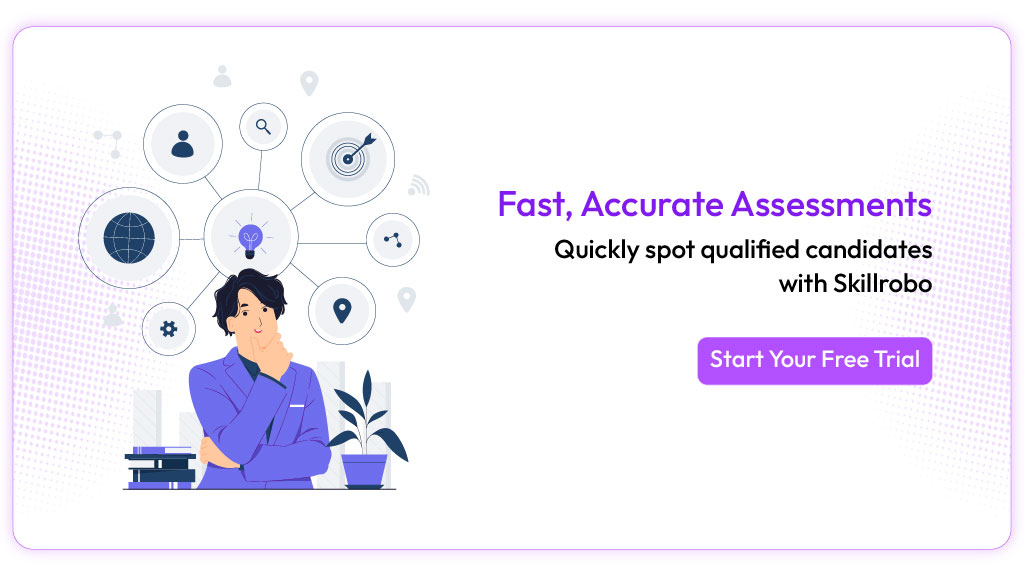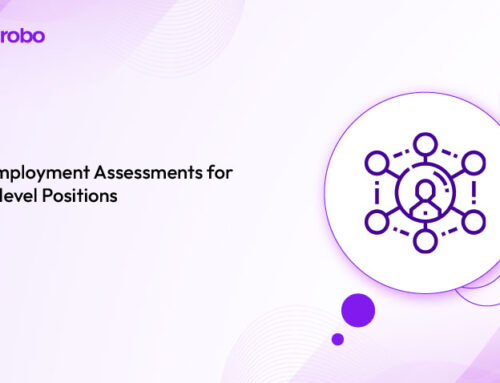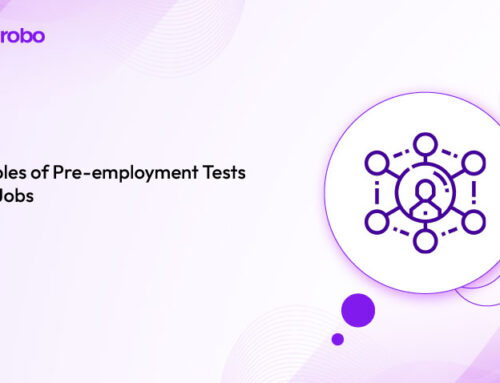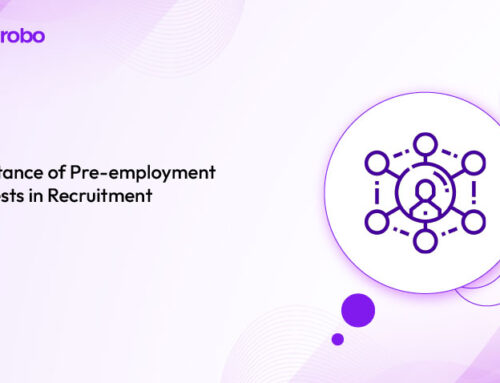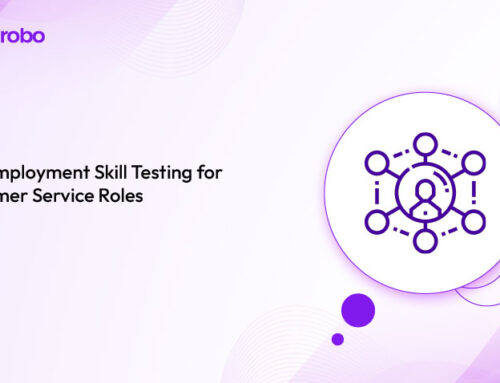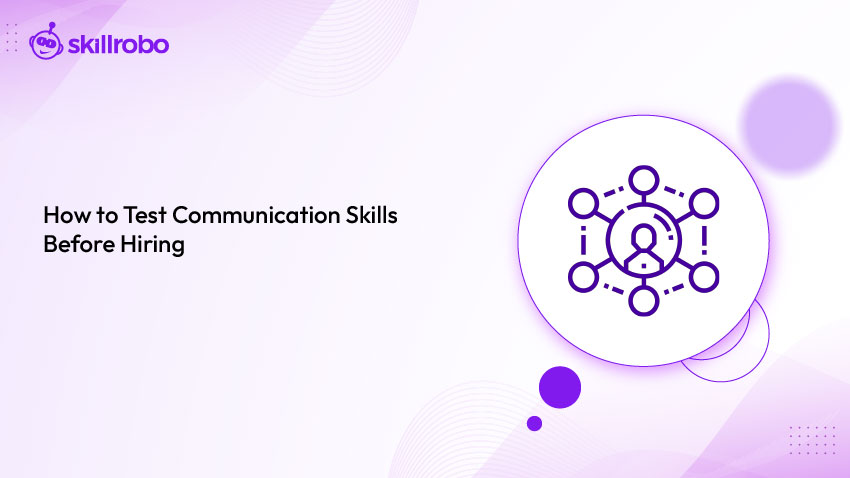
Key Takeaways
- Communication skills drive collaboration, leadership, and client success across all roles.
- Structured tests deliver objective insights into verbal, written, and interpersonal abilities.
- Early communication assessments cut guesswork, identifying top talent faster in hiring.
- Skillrobo’s customizable tools streamline testing, scaling for diverse, communication-heavy roles.
Poor communication in the workplace leads to misaligned expectations, reduced productivity, and conflict among teams. That’s why communication is one of the most important soft skills to assess during hiring. But evaluating it accurately, especially before an interview, can be challenging without the right tools. Many candidates list “excellent communication skills” on their resumes, but that doesn’t guarantee effective expression, listening, or comprehension in real-world settings. To make informed hiring decisions, recruiters must use structured, role-relevant methods to test communication skills early in the process. In this blog, we’ll explore the benefits and methods to test communication skills before hiring.
Why Communication Tests Are Essential
Communication is the glue that holds teams together, yet it’s often misjudged in hiring. Poor communication sparks conflicts, stalls projects, and frustrates clients, costing firms productivity and trust. Resumes claim “excellent communication,” but do candidates truly listen, articulate, or adapt under pressure? Interviews catch charisma, not daily clarity. Pre-employment tests solve this, objectively probing real-world skills early. A 2023 study found that 72% of HR leaders prioritize communication for team success. By testing before interviews, you ensure hires align with role demands, building teams that connect, collaborate, and deliver, no matter the industry or setting.
1. Prevents Workplace Misalignment
Miscommunication derails goals. Tests like drafting team updates reveal who aligns with groups. A firm lost time to vague hires—tests catch clear communicators. For coordination or leadership roles, this avoids chaos. Early checks ensure hires sync teams, boosting efficiency. It builds workplaces where expectations match outcomes, critical for fast-paced or remote settings.
2. Reduces Team Conflict
Clear expression prevents friction. Scenarios like resolving disputes show who calms tensions. Poor communicators spark clashes, hurting morale. For HR or service roles, diplomacy matters. Tests spotting this trait ensure hires foster harmony, keeping teams tight. This cuts disruptions, ensuring projects flow smoothly, especially where collaboration is key to success.
3. Enhances Client Trust
Client-facing roles need sharp communication. Tasks like handling inquiries test who builds loyalty. Weak hires frustrate customers, losing business. For sales or support roles, trust is everything. Tests ensure hires engage effectively, boosting retention. This drives revenue and reputation, creating teams that turn interactions into lasting relationships.
4. Supports Remote Work
Virtual teams lean on clear chats. Challenges like async updates reveal who syncs remotely. Muddy messages stall dispersed groups. For tech or marketing roles, virtual clarity is vital. Tests catching this ensure hires thrive online, keeping workflows fluid. This builds distributed teams that connect across time zones, critical in today’s hybrid world.
5. Predicts Leadership Potential
Leaders inspire through words. Tasks like guiding discussions show who is motivated. Weak communicators falter, losing influence. For management or exec roles, vision matters. Tests spotting this trait ensure hires lead with impact, rallying teams. This builds a pipeline of talent ready to steer projects and people, driving long-term growth.
Benefits of Structured Assessments
Structured communication tests are a hiring superpower, cutting through resume fluff to reveal true ability. They ensure fairness, speed, and fit, transforming recruitment into a precise science. By probing verbal, written, and interpersonal skills, they save time and reduce risks, building teams that shine in roles from support to strategy. These benefits make them indispensable for HR aiming to craft high-performing, cohesive workplaces.
1. Ensures Objective Evaluation
Uniform scoring, like rating clarity, cuts bias. A firm once favored charm over skill, but tests fixed that. For any role, this ensures fairness. Consistent metrics deliver trusted results, letting all candidates shine. It creates transparent hiring, critical for diverse pools, ensuring hires reflect ability, not subjective impressions unfair hiring.
2. Speeds Up Screening
Manual reviews slow hiring. Tests like email responses filter talent fast. A retailer lost stars to delays—automation won them back. For high-volume roles like service or sales, speed matters. Tests focus HR on top performers, streamlining decisions. This keeps recruitment agile, landing hires before competitors in tight markets.
3. Improves Role Fit
Tests match skills to jobs, like writing for reports. Mismatched hires flopped at a tech firm—tests prevented repeats. For ops or leadership roles, fit drives success. Tailored tasks ensure hires meet demands, easing onboarding. This boosts retention, building teams that stick and perform, saving long-term costs.
4. Enhances Team Cohesion
Strong communicators unite groups. Challenges like team briefings spot connectors. Weak links fray trust, hurting output. For HR or coordination roles, synergy is key. Tests ensure hires strengthen bonds, lifting morale. This creates teams that collaborate smoothly, driving collective wins in any fast-paced or creative sector.
5. Reduces Training Needs
Job-ready hires ramp up fast. Tasks like client replies show who needs less coaching. A firm cuts training costs with skilled hires. For support or marketing roles, this saves resources. Tests spotting proficiency ensure hires contribute early, keeping teams lean. This drives efficiency, especially in resource-tight settings.
Key Areas to Evaluate
Communication is more than words—it’s a mix of skills that shape job success. Testing the right areas ensures hires meet role demands, from client chats to team syncs. Skillrobo tailors assessments to probe these competencies, delivering insights with Seyarc AI precision. By focusing on these five areas, HR can pinpoint talent who communicates with impact, building teams that thrive in any context.
1. Verbal Clarity
Clear speech drives influence. Tasks like oral summaries test tone and articulation. Muddy talkers confuse teams or clients. For sales or training roles, this is non-negotiable. Tests ensure hires speak confidently, boosting engagement. This builds teams that inspire trust, critical for presentations or client-facing tasks.
2. Written Precision
Strong writing organizes ideas. Challenges like drafting emails test grammar and structure. Sloppy writers slow workflows or lose clients. For ops or marketing roles, clarity matters. Tests spotting this ensure hires craft professional messages, streamlining tasks. This drives efficiency, ensuring teams deliver polished work without constant edits.
3. Active Listening
Listening fuels understanding. Audio-based questions test recall and comprehension. Poor listeners misstep, causing errors. For support or HR roles, this is vital. Tests ensure hires grasp details, reducing mix-ups. This builds teams that align fast, critical for collaborative or customer-driven settings where accuracy counts.
4. Tone Adaptability
Flexible tone fits varied audiences. Scenarios like client vs. team replies show who adjusts. Rigid communicators alienate stakeholders. For leadership or service roles, nuance is key. Tests spotting this ensure hires adapt, fostering trust. This creates teams that navigate diverse interactions, boosting impact across contexts.
5. Non-Verbal Cues
Body language signals confidence. Video tasks test posture or eye contact. Weak cues undermine credibility in client or lead roles. Tests via video tools on Skillrobo catch this. Hires who excel here engage better, lifting their presence. This builds teams that connect visually, key for virtual or in-person settings.
Effective Testing Methods
Choosing the right test methods ensures communication skills are measured accurately and fairly. Methods must reflect job realities and use clear scoring to reduce bias. By blending techniques, HR can assess verbal, written, and interpersonal abilities with precision, ensuring hires shine in roles from tech to customer service. These approaches make testing practical and reliable.
1. Situational Judgment Tests
SJTs use scenarios, like handling complaints, to test communication choices. A firm hired a dud who flubbed conflicts—SJTs fixed that. For support or management roles, this predicts behavior. Candidates rank responses, showing judgment. This ensures hires navigate real issues, boosting team and client outcomes.
2. Writing Simulations
Job-like tasks—like client emails—test grammar and tone. Sloppy writers cost a retailer clients—simulations caught stars. For ops or sales roles, this checks professionalism. Scoring clarity and structure ensures hires communicate well. This builds teams that craft clear messages, streamlining workflows without errors or rework.
3. Video Response Tasks
Video prompts—like explaining ideas—test verbal and non-verbal skills. A tech firm missed shy talent—videos revealed gems. For sales or training roles, this shows presence. Timed tasks measure clarity under pressure. This ensures hires engage confidently, critical for presentations or client-facing tasks.
4. Listening Comprehension
Audio clips with questions test understanding. Poor listeners at a firm caused errors—tests fixed it. For HR or service roles, recall is key. This ensures hires grasp instructions, cutting mistakes. It builds teams that align fast, boosting accuracy in collaborative or client-driven settings.
5. Structured Virtual Interviews
Prompt-based interviews with rubrics test live communication. Unstructured chats missed a firm’s stars—structure won. For leadership or coordination roles, this checks adaptability. Scoring responses ensures fairness, catching hires who guide discussions. This builds teams that communicate with impact, even in dynamic scenarios.
Practical Applications Across Roles
Communication tests shine by solving hiring challenges across sectors, catching talent who connect and perform. These applications show how assessments are delivered, offering ideas to adapt for your needs. From retail to projects, they ensure teams communicate with clarity, driving results in any role or setting.
1. Retail Service
Retail needs engaging reps. Scenarios like client queries test who builds trust. Weak talkers lose sales. This fits cashier or support roles, ensuring hires handle complaints. It builds teams that boost loyalty and revenue, keeping service seamless in busy or online settings.
2. Tech Collaboration
Tech demands clear syncs. Tasks like team updates spot hires who align with the coders. Poor communicators stall projects. This suits developer or analyst roles, catching talent who can clarify complex ideas. It ensures teams deliver innovation, keeping workflows fluid in fast-paced environments.
3. Operations Coordination
Operations need precise briefs. Challenges like process explanations show who streamlines. Vague hires slow teams. This works for logistics or planning roles, catching clear communicators. It builds crews that hit targets, ensuring operations stay tight across complex or remote workflows.
4. Customer Support
Support roles thrive on empathy. Scenarios like resolving issues highlight who calms clients. Bad hires lose trust. This fits call center or service roles, catching talent who retain customers. It ensures teams boost satisfaction, delivering experiences that strengthen brand loyalty.
5. Project Leadership
Projects need inspiring voices. Tasks like guiding plans show who rallies teams. Weak leaders derail goals. This suits PM or exec roles, catching hires who motivate. It builds teams that deliver on time, ensuring projects succeed with clarity under tight deadlines.
Avoiding Common Pitfalls
Even top tests can falter—bias, complexity, or poor design skew results. Addressing these keeps assessments fair and effective, ensuring HR catches talent who shine. These tips help dodge traps, crafting processes that deliver communicators for any role, from tech to service, with precision and inclusion.
1. Eliminate Bias
Culturally loaded tasks block talent. Neutral scenarios—like drafting updates—let all compete. A biased test loses stars—fair design wins. Check questions for jargon, suiting support, or marketing roles. Inclusive tests catch diverse communicators, boosting varied teams without unfair hurdles.
2. Simplify Test Design
Dense tasks, like complex prompts, confuse. Clear challenges, like email replies, focus on skill. A tough test cut completion—simplicity brought talent. Offer guides for ops or HR roles. Streamlined tests keep engagement high, ensuring candidates show their best, landing hires who communicate clearly.
3. Update for Relevance
Stale tests miss modern needs, like virtual chats. Refresh tasks with async scenarios. A dated test hired flops—updates fixed that. Track trends for tech or leadership roles. Current tests ensure hires tackle today’s demands, keeping teams agile in evolving workplaces.
4. Support Candidate Experience
Stressful tests—like rigid timers—hide talent. Flexible windows and clear rules ease nerves. A rushed test lost hires, support won stars. Prep guides suit service or sales roles. This ensures tests measure ability, catching communicators who thrive with confidence.
5. Ensure Job Alignment
Random tasks—like trivia—miss fit. Tie tests to jobs, like client responses. A firm hired a dud with broad tests—relevance fixed it. Align with needs for strategy or support roles. This ensures hires communicate effectively, boosting impact without retraining.
Conclusion
Communication skill tests revolutionize hiring, spotlighting talent who connect, lead, and deliver with clarity. By mirroring job demands, they catch hires who unify teams, charm clients, and drive results, building workplaces that don’t just function—they thrive. From fair designs to role-specific tasks, each step sharpens your recruitment edge. With Skillrobo’s customizable, AI-driven platform, you can assess communication at scale, ensuring every hire fits and performs. Ready to build teams that communicate with impact? Sign up today to transform your hiring strategy.

